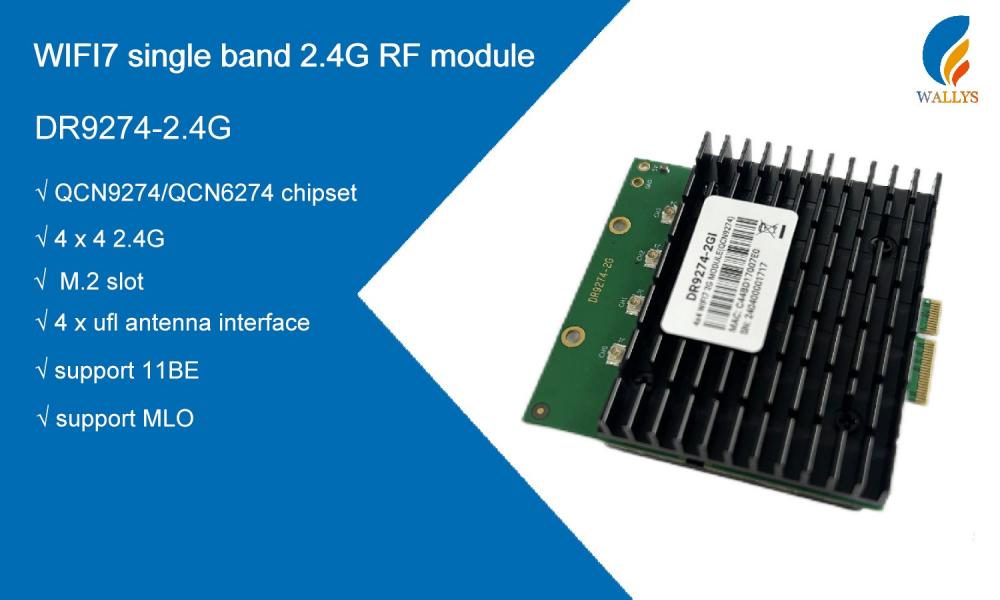## QCN6224, QCN6274, QCN6024 three kinds of chip difference and WiFi 7 technical analysis
### Foreword
With the continuous progress of wireless communication technology, WiFi standards are constantly updated. The latest WiFi 7 (IEEE 802.11be) standard is becoming the focus of the market. This article will take a closer look at the QCN6224, QCN6274, and QCN6024 chips, discussing the key differences between them and why the former two support WiFi 7 while the latter does not.

QCN6224, QCN6274, QCN6024 chip overview
#### QCN6224 and QCN6274
The QCN6224 and QCN6274 are Qualcomm's latest wireless chips designed to support the WiFi 7 standard. The key features of these two chips include:
1. ** High throughput ** : Support up to 30Gbps data transfer rate.
2. ** Multi-channel support ** : It can be transmitted on multiple channels at the same time, improving spectral efficiency.
3. ** Multiple user Multiple Input Multiple Output (MU-MIMO) ** : Provides efficient wireless connectivity for multiple devices at the same time.
4. ** Wider channel bandwidth ** : Support 320MHz channel width, improve the data transmission speed.
5. ** Enhanced QAM (Quadrature amplitude modulation) ** : Support 4K-QAM, which greatly improves the data transmission efficiency than the previous generation of 1024-QAM.
6. ** Low latency ** : Reduce transmission delay through a variety of technical means, suitable for real-time applications.
#### QCN6024
QCN6024 is a previous Qualcomm wireless chip, mainly support WiFi 6 (IEEE 802.11ax) standard. Its main features include:
1. ** High throughput ** : Support up to 9.6Gbps data transfer rate.
2. **OFDMA (Orthogonal Frequency division Multiple Access) ** : improves spectrum utilization and transmission efficiency.
3. **MU-MIMO** : Supports simultaneous connection of multiple devices.
4. **160MHz channel width ** : compared with WiFi 5's 80MHz, there is a significant improvement.
### WiFi 7 technical features
WiFi 7, as the IEEE 802.11be standard, is a comprehensive upgrade of WiFi 6, with the following significant features:
1. ** Higher speed and capacity ** : WiFi 7 supports a maximum throughput of up to 30Gbps, three times that of WiFi 6.
2. ** Wider channel bandwidth ** : expanded from 160MHz to 320MHz of WiFi 6, improving data transmission speed and spectral efficiency.
3. ** Higher QAM** : Support 4K-QAM, making data transmission more efficient.
4. ** Multi-Link Operation (MLO) ** : Allows the device to transmit simultaneously on multiple frequency bands, improving the stability and speed of the connection.
5. ** Enhanced MU-MIMO** : Support more devices to connect at the same time, improving network capacity.
6. ** Reduced latency ** : Optimized technology reduces network latency and improves user experience.
Technical analysis: Why does the QCN6224 and QCN6274 support WiFi 7, but the QCN6024 does not?
#### Hardware architecture
Many of WiFi 7's improvements require support from the underlying hardware architecture. The QCN6224 and QCN6274 were designed with these requirements in mind, such as higher processing power, wider channel support, and enhanced QAM capabilities. Due to its early design, the QCN6024 hardware architecture does not support the technical features required for WiFi 7.
#### channel bandwidth
WiFi 7 supports up to 320MHz channel bandwidth, while the QCN6024 only supports 160MHz. This means that the QCN6024 cannot meet the bandwidth requirements of WiFi 7 on the hardware, which limits its improvement in data transmission rate.
#### Multi-link operation
WiFi 7 introduces multi-link operation (MLO), which allows devices to transmit data simultaneously over multiple frequency bands. The QCN6224 and QCN6274 have the hardware and software capabilities to support this feature, while the QCN6024 was not designed with this feature in mind and therefore cannot achieve this.
#### Higher QAM
The QCN6224 and QCN6274 support 4K-QAM, while the QCN6024 only supports 1024-QAM. This difference allows the first two to achieve higher data transfer efficiency at the same bandwidth.
#### Processing capacity
The complex nature of WiFi 7 requires more processing power. The QCN6224 and QCN6274 are equipped with stronger processors and higher memory bandwidth to handle the complex protocols and large data volumes of WiFi 7, while the QCN6024's processing power is relatively insufficient to meet the needs of WiFi 7.
### Conclusion
The QCN6224 and QCN6274 meet the technical requirements of WiFi 7 due to their advanced hardware architecture, support for wider channel bandwidth, multi-link operation, support for higher QAM modulation, and enhanced processing power. Due to its early design, the hardware and software architecture of QCN6024 cannot support the features of WiFi 7, so it can only support the WiFi 6 standard. As wireless communication technology continues to evolve, chip upgrades will continue to drive the advancement of wireless networks, bringing users a more efficient and faster connection experience.
Wallys software technology advantages:
Wallys has 10 years of experience in software development and is very experienced in uboot, Linux, wifi protocol, wifi performance, OS and other systems. It mainly uses Qualcomm chips to develop important software such as drivers and kernels, and has the ability to modify and compile to meet customers' different wifi functional requirements. Meanwhile, it participates in openwrt organization and code development. wifi5 product DR40x9 has been officially supported by openwrt.
Hardware technology advantages:
We have a strong hardware design team, and experienced people know that the most difficult part of hardware design is RF circuit design, baseband, etc., while wallys team made 0 error to achieve signal integrity, such as frequency conversion of network card, from 2.4G to 900M, which is a technological breakthrough.
Clients: TIP,Facebook, Openwrt, etc
Email:sales@wallystech.com
WEB:https://www.wallystech.com/
*博客内容为网友个人发布,仅代表博主个人观点,如有侵权请联系工作人员删除。
1721030087 阅读:2324